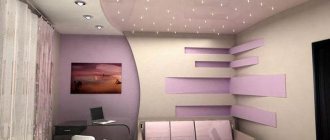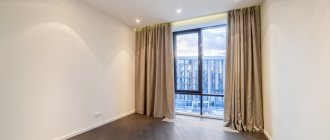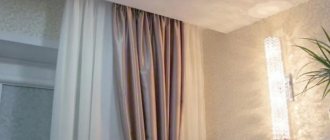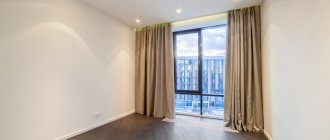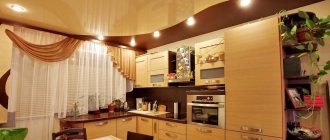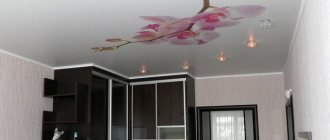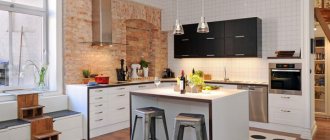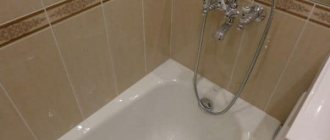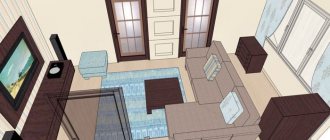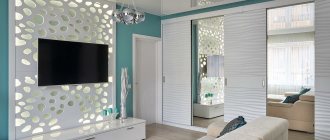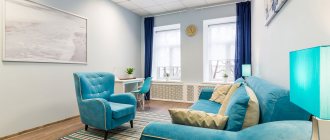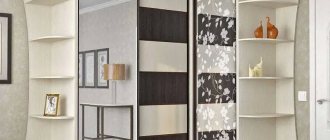Spotlights are compact lighting devices of varying power. They can serve as additional lighting, decorative lighting, and can also completely replace a chandelier. The location of lamps on a suspended ceiling in a living room, bedroom, or nursery is determined by what task they perform.
Depending on the task at hand, the power of the devices, the dimensions, and the appearance are chosen, because the decor of the lamps must match the style of the room.
Selecting spotlights for placement on a suspended ceiling
Not all lamps are suitable for a suspended stretch ceiling. The film fabric is very thin and light. Installation of spots involves installation on the base ceiling and the formation of holes in the canvas for lighting fixtures.
It is necessary to take into account another feature of the tension film: the material does not tolerate high temperatures. This eliminates the use of devices with too high power, as well as incandescent or metal halide lamps: the latter become very hot, which leads to deformation of the film.
Accordingly, the most important selection parameter is the type of light source and power:
- If an incandescent lamp is used, its power should not exceed 40 W. It is possible to install a lamp with a power of up to 60 W on a fabric sheet, since polyester is more resistant to temperature;
- The halogen lamp heats up even more. The maximum for PVC film is a product with a power of 20 W;
- LED devices do not heat up regardless of power, since this model includes special heat-dissipating devices.
Which lamps are best for a suspended ceiling in a living room or bedroom is determined by the height of the room and the design of the ceiling.
Lamps are classified according to installation method:
- overhead – the best option for stretch film . The device includes a mounting pad, which is installed on the base surface, and a housing. The hole under the PVC film lamps should be smaller in diameter than the body of the product;
- built-in - mounted on a frame base . The models are indispensable for multi-level combined ceilings. Lamps are installed inside ready-made holes in the partition or ceiling, in places where cables are connected. The device body already includes fastening elements for the lamp and clamps. This design makes it easy to replace the lamp or the entire device in case of repair;
- suspended - an option used when there is a larger distance between the base ceiling and the tension fabric . In this case, the product body is fixed to the power cable at an arbitrarily large distance. If there is a large mass of devices, it is recommended to pre-fix mounting rails to the ceiling - made of timber, for example,
Important ! When installing recessed luminaires on a tension fabric, only LED devices may be used.
Working in the light or relaxing requires different levels of lighting. This issue is also solved with the help of spotlights.
In this case, when choosing, you need to pay attention to the design features:
- Stationary lamps . Most built-in models are of this type;
- rotating - allow you to create directional lighting by changing the position of the body. When installing such a lamp, the installation area is pre-strengthened;
- gimbals include several LED elements, and therefore allow you to vary the lighting intensity and direction over a wider range;
- rotary-retractable - an interesting option, which, however, requires manual adjustment, since the body can only be pulled out with your hands;
- spots - equipped with a rotating mechanism and manually adjusted. Spots come in a variety of varieties, but most often they consist of several lamps installed on a common fastener.
Spotlights for suspended ceilings, the design of which is not replete with variety, have an appearance that is determined by a luminous surface and a decorative frame. The latter may not exist, which for most modern styles is an additional plus. The main advantage of the solution is its high functionality and the possibility of installation on a film ceiling.
Lamps with G5.3 socket
On sale you can find lamps with a base of this format, both halogen and spot. Popular due to its moderate cost and ease of replacement. Previously, there were halogens that had a defect in the additional diffuser, which distributed light under the stretched film. As a result, one could see all the imperfections of the ceiling, unevenness, communications stretched under the canvas. Modern models do not have this drawback.
One of the most significant drawbacks in suspended ceilings is the deep fit inside the panel, which seems to be the main reason for poor dispersion. Since the light comes out at a right angle and the lighting is too harsh. Spots of this type are often used in children's rooms and corridors.
We calculate the number and location of lamps on a suspended ceiling
Models for suspended ceilings are selected not only by functionality or design. Taken together, all lighting fixtures must provide sufficient illumination, as well as create decorative effects when necessary. Accordingly, if spotlights play the role of complementing a chandelier, a certain arrangement is used. If lighting is provided only by these devices, their arrangement should be different.
To calculate the optimal location of lamps on a suspended ceiling, you need to know:
- type of lighting fixtures – fluorescent, LED incandescent lamps generate luminous flux with different intensities;
- room size - 1 spot can provide lighting of no more than 2 square meters. m. area;
- presence, number and area of windows;
- living room design - style also dictates certain requirements for the layout;
- the need for zoning - spotlights successfully solve the problem of dividing into zones.
Power calculation
There are certain lighting standards for all types of rooms:
- for the living room, at least 3 W per 1 square meter is required. m;
- in the bedroom there is no need for such bright lighting - 2 W per 1 square meter is enough. m;
- but in the nursery the lighting should be maximum - 8 W per 1 sq. m.
The photo shows the lighting of stretch ceilings with light bulbs.
Based on the norm, you can easily calculate the required total power. For example, with a living room area of 20 sq. m requires lighting with a power of 20 * 3 = 60 W. If there is no central lighting device, with a power of LED lamps of 5–7 W, you will need from 10 to 14 devices. Preference is given to an even number, but this condition is proportionate to the design.
The photo shows lamps for suspended ceilings in the living room.
Selecting a layout
Depends equally on the required level of lighting and on the style. In addition, you need to keep in mind additional requirements determined by the purpose of the room.
The living room is a room with a high level of lighting. It’s unlikely that you can get by with spots alone.
But if you use them together with a chandelier, you can greatly diversify the design of the room:
- lamps are used for zoning: in areas where bright lighting is required, devices are placed in a close group or high-power products are selected. In the recreation area, on the contrary, they are used to organize subdued soft lighting;
- it is preferable to place light bulbs on a suspended ceiling in a room in front of a wall with an interesting decor or furniture composition;
- 2 rows of point light sources along a shorter wall will allow you to visually correct the proportions of the room.
The photo shows lamps for suspended ceilings in the living room.
Bedroom – here they often do without a chandelier. Areas are marked with spotlights:
- A couple of pieces are enough above the bed to create very soft lighting;
- The wardrobe is highlighted with more powerful lighting fixtures. The person changing clothes must see himself in the mirror;
- the dressing table also needs good lighting.
Kitchen. The spots here provide sufficient illumination and serve as a universal tool for zoning. They allow you to visually change the proportions of the room.
The nursery assumes the best possible illumination, which is impossible without a central chandelier. Spot models provide additional lighting. Here, the placement of lamps is determined not so much by the beauty of the ceiling as by the needs of the child.
In the hall or corridor, the choice is small: the light is placed either around the perimeter or along the center line.
The choice of scheme is also influenced by the style of the room. So, in a classic-style living room, the placement should be symmetrical. In a hall with a modern design, an asymmetrical arrangement is allowed.
Additional lighting devices
They are installed in a corner for reading, handicrafts, when light accents and highlighting of bright interior items are needed - for example, paintings, stucco moldings, decorations, etc. These are:
- Wall lights . They can be built-in or overhead (sconces), in design - armature, wall-mounted (used in a narrow space, as a backlight for pictures), stationary, adjustable, with a reflected and directed beam. When the main lighting is turned off, sconces create a cozy atmosphere; they are installed near the reading chair to emphasize the interesting texture and stucco molding. Wall sconces in the work area replace a table lamp. When placing sconces, you need to make sure that they do not interfere with the passage.
- Floor lamps . This is the common name for a floor lamp. Typically, such a device has a leg (straight, curved, or even adjustable in height or offset). Thanks to the lampshade and diffuser, the device produces dim, diffused light. The beam is directed up or down, in both directions. But the cap is an optional attribute; models are produced without this detail. Floor lamps can be stationary or portable, with one or more lamps.
- Bottom lighting . Floor-recessed lamps are still rarely used, although they look very impressive, especially in recreation rooms. They are usually built into podiums - like ceiling “points”.
- Desk lamp . They are also placed on the fireplace, bedside tables, near the sofa if they are working on it, etc.
- Optical fiber . This light source is economical and, most importantly, safer than its analogues. It can be used even in damp areas. Optical fiber emits light in transverse and lateral projection. This allows you to create a variety of compositions - for example, the popular “starry sky”. The fiber is cut even when it is turned on - no current is transmitted through it. Although the material is used for the main lighting, its task is still auxiliary lighting.
Minimum distance between lamps on a suspended ceiling
The tension fabric has a number of design features; when installing point models, they also need to be taken into account:
- Lamps on the suspended ceiling in the hall should be distributed so that there is at least 20 cm from the wall to the spot;
- between built-in models the distance is maintained at least 30 cm;
- if the tension fabric includes several fragments, lamps cannot be mounted at their junction. They can be placed no closer than 15 cm from the seam.
How the lamps are placed on the suspended ceiling in the hall does not depend on their power. However, when choosing a placement scheme, you need to divide the groups in advance into the main ones - with higher power, and the secondary ones - less powerful, used, rather, for illumination.
Advantages and disadvantages
A chandelierless lighting system has several important advantages:
- you can illuminate a room of any size with high quality;
- lighting is uniform and uniform;
- a variety of lamps allows you to organize both main lighting and accent lighting;
- the room space looks freer and less busy;
- a large selection of lighting design options for functionality and style for each room.
There is only one drawback - not all apartment owners are ready to give up their favorite chandelier and replace it with alternative lighting equipment.
Popular layouts for placing lamps on a suspended ceiling in combination with a chandelier
The location of additional lighting devices is primarily determined by the position of the central one - the chandelier. There are options here too: in a classic small living room, the chandelier is fixed exactly in the center, and spotlights are placed symmetrically around it. In modern styles, a chandelier marks the most important area of the living room, and lighting is grouped by zone. In this case, asymmetry is allowed.
The options for placing spotlights on a suspended ceiling are as follows:
- An oval is a great way to visually correct the proportions of a long and somewhat narrow living room . A chandelier is installed in the center, and spots are placed around in the form of an oval. Part of the ceiling may be darkened;
- circle - ideal for a square living room;
- 2 semicircles - with modern design, arcs can have different lengths and bending radii . A simple and at the same time extremely effective way to visually correct the proportions of a room;
The photo shows a circular arrangement of spotlights on a suspended ceiling in the hall.
- framing - this means installing lighting on a plasterboard ceiling box around the perimeter. The scheme emphasizes the proportions of the room;
- A classic option for a kitchen or small bedroom is to install spotlights parallel to two shorter walls. In this way, they achieve visual expansion of a narrow room;
- corner – point models are fixed along the corner symmetrically or asymmetrically. This method is only permissible in modern styles, and is very popular when zoning;
- grouping - applicable in a studio apartment . At the same time, in the guest area, for example, a chandelier is hung, and in the area where the owner of the home is resting, a group of lamps is placed;
- an arbitrary combination is also usually asymmetrical . In this case, a row of lamps is placed in the form of a wave, zigzag, semicircle, and so on.
The photo shows how to place spotlights on a suspended ceiling in the hall.
When choosing a pattern, the nature of the canvas is also taken into account. The glossy film reflects light, so you'll need fewer fixtures to illuminate your living room or bedroom. Matte or velvet fabric even absorbs light: more lamps are needed here.
Design elements
Illuminated photographic suspended ceilings have many advantages, one of which is the ability to adjust the lighting inside, which helps create the desired unique effect.
To create interior lighting, several types of lamps are used, for example:
- Fiber optic lighting;
- Fluorescent lamps;
- LED strip.
Layout diagrams of lamps on a suspended ceiling without a chandelier
How to place lamps on a suspended ceiling without a chandelier also depends on the style and its proportions. Sufficient lighting will require more bulbs and higher wattage.
Spot layouts can be either symmetrical or asymmetrical. Filling the central section of the stretch ceiling is optional.
It is even possible to evenly place spotlights over the entire area, although this is not the most successful way:
- two semicircles are the optimal way to illuminate a living room or nursery using only spotlights. By varying the power of the lamps and the bending radius of the arc, uniform illumination is achieved;
- cross-shaped arrangement is an original option, suitable for a room of any proportions and sizes.
The photo shows the arrangement of light bulbs on the suspended ceiling in the hall;
- wave or zigzags - relevant for rooms with complex configurations. This arrangement allows you to create lighting in all areas of a pentagonal, highly elongated room, kitchen or living room with a bay window;
- arbitrary grouping - spots are placed in the form of a combination of a circle and arcs, an oval and a circle, waves and a frame around the perimeter. A big plus of this option: the ability to select the lamp power depending on the zone;
- drawing - performs the same functions as grouping, but at the same time the spots form some kind of figure.
The photo shows spotlights for suspended ceilings in the living room interior.
When choosing a scheme, the general principle is followed: the work area should be as saturated with spots as possible, and in the recreation area, the decorative effect of the lamp is more important than its power.
Base G9
This type is in the middle in terms of efficiency and comfort. The protrusion of the bulb is much stronger, which contributes to a powerful luminescent spread. All types of lamps are developed for this format. Suitable for industrial premises, studios, workshops, photo studios, since the beam covers the entire room.
How to install spotlights on a suspended ceiling
Installation of spots on a tension fabric involves attaching the lamp itself to the base ceiling. Lamp manufacturers have made installation as easy as possible. The product is supplied with an installation platform and the necessary fasteners. In addition, when attaching to PVC film, you will also need a thermal ring.
The procedure is as follows.
- Mounting points are marked on the base ceiling. Holes for the dowel are first made in the concrete surface; the installation platform is simply secured into the wood with self-tapping screws.
- Lay a cable to each output and secure it to the ceiling with brackets or clamps.
- After completing other preparatory work, stretch the PVC film.
- To prevent heating of the canvas, thermal rings are used. They are selected in advance according to the diameter of the lamp. After the suspended ceiling has been installed, the lamp mounting areas are marked.
- Special glue is applied to the thermal ring and secured to the canvas. The glue sets within 3–5 minutes. Then the fabric inside the ring is cut and its excess is removed.
- The lamp is inserted into the resulting hole, making sure that the spring antennae are behind the installation ring. If there is a small gap left between the canvas and the edge of the body, there is no need to remove it.
If spots are installed on a tire, the installation is done slightly differently. The holes are made for suspensions, that is, there is no need for thermal rings.
Review of manufacturers
There are many brands on the lighting market, whose products you can find in stores. Those who want to save money and use equipment for a long time can buy products from the following manufacturers.
Ecola. Lighting engineers emphasize the capabilities and value of this brand. The Chinese manufacturer has many positive reviews about its products. All models are equipped with a moisture protection system and are easy to install. Having top-segment qualities, they are inexpensive. Only environmentally friendly materials are used in production. The catalog contains models for any base, including table lamps. They have low heat generation, a body made of impact-resistant plastic that is not prone to temporary changes. Does not oxidize in air, does not turn black when overheated and does not emit toxic substances into the atmosphere.
Philips. A Dutch brand that focuses on practicality and minimalism. It is protected from moisture and is resistant to power surges. The Philips stretch ceiling lamp is undemanding during installation and will fit any interval between the ceiling and the film. The entire catalog has European certification and is allowed for sale by PUE and SNiP. The catalog includes flat spots and lamps with remote control. They belong to the moderately expensive segment.
Citilux. Danish manufacturer creating innovations in the lighting equipment segment. Ceiling lights for suspended ceilings "Citylux" are resistant to vibration, moisture, and mechanical damage. The products are available and have European certification. Does not require constant maintenance, easy to install. Experts are in demand for their price and environmental friendliness. Top models are equipped with flood protection. Even if there is a flood from above, there will be no short circuit inside the light bulb.
